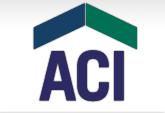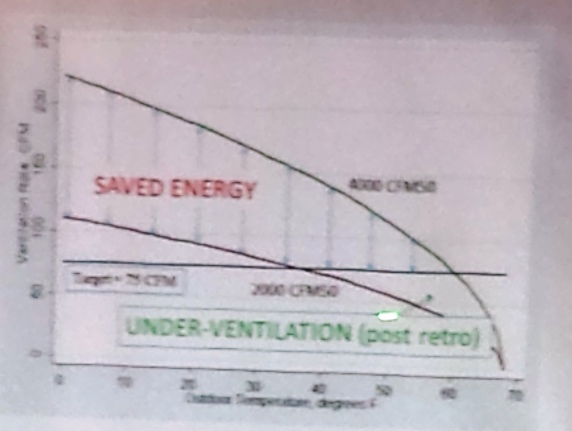 This is our second of three articles dealing with the ACI conference I attended back in late April. This one is specifically dealing with ventilation, which includes the Great Ventilation Debate which was originally titled; “The Ventilation Standard Debate – The Real Housewives of 62.2.”
This is our second of three articles dealing with the ACI conference I attended back in late April. This one is specifically dealing with ventilation, which includes the Great Ventilation Debate which was originally titled; “The Ventilation Standard Debate – The Real Housewives of 62.2.”
As I have stated before – ventilation is needed in all houses, not because houses need to breathe but the humans & pets inside do. I also believe that in most cases the arbitrary numbers of 62.2.10 used are too high, explained the issues in humid climates with running items 24×7, and even how I have dealt with them. Well out comes .13 which almost doubles the amount of ventilation and my jaw hit the floor. Fortunately I consider myself open minded and at ACI they had numerous pieces on the new standards straight from the horses mouth (so to speak) so I did load up on many of these sessions… So with no further ado, my notes & thoughts…
IAQ: Indoor Air Quality in Tight Homes
This session was put on by Brennan Less & Ian Walker of LBNL who also is part of the 62.2 committee.
- There is no one right answer to IAQ – Ian Walker
- A pollutant is anything that bothers you (i.e. pollen, smoke) or exceeds safe deemed “safe limits.”
- “Safe Levels” for containments = answers are uncertain or non-existent as people react differently
- An electric oven is actually the worst “pollutant” wise as it releases more “particulates” – best oven is an induction unit.
- Tightening a house does not change source pollutants just the ELA but energy efficient houses generally have the best IAQ.
- Increasing ventilation actually increases formaldehyde levels by some 20% to 60% over original predictions
- 3 ACH gets you 80% of the “energy savings” that are achievable
- 5.5 ACH is national average for homes built past Y2K & tested by numerous agencies, programs, studies, etc…
- Typical reductions for existing houses – 20% for utility based programs, 30% for Weatherization Assistance, & 63% for Deep Energy Retrofit programs
Temperature Based Ventilation Controls:
As part of the 62.2 process, & sponsored by some grant money from Building America… a study is underway about adding in temperature-based controls to eliminate ventilation during the coldest part of the year. Why? Well that is because stack effect accompanied by the buildings leakiness allows for “enough ventilation to occur naturally”… Of course as it gets warmer (essentially when most are actually throwing open windows in those areas that this would actually work in) the ventilation system is then needed.
 In all reality the entire premise is flawed, the arguments are week & as pointed out by an LBNL study this will do no good for any house that has 5 or less ACH. Interestingly Canada’s HOT system models an HRV as only running during the colder parts of the year & being shut off when most people throw open the windows. Another interesting tidbit is while they opened the session talking about the two extremes (really cold areas like Maine, Vermont, North Dakota and super-hot areas like Las Vegas & Phoenix) as the reason for this study, they never talked about the hotter climates at all.
In all reality the entire premise is flawed, the arguments are week & as pointed out by an LBNL study this will do no good for any house that has 5 or less ACH. Interestingly Canada’s HOT system models an HRV as only running during the colder parts of the year & being shut off when most people throw open the windows. Another interesting tidbit is while they opened the session talking about the two extremes (really cold areas like Maine, Vermont, North Dakota and super-hot areas like Las Vegas & Phoenix) as the reason for this study, they never talked about the hotter climates at all.
On the good news front for many, word did get out about the committee adopting a de minimus level in an interim version, which means that if you need less than 15 CFM of ventilation you don’t need to install a system. (Assuming your local Building Official adopts it)
The Great Ventilation Debate:
In all regards this was not a debate, but rather a blowout. Joe Lstiburek was essentially pitted against 5 members of 62.2 committee & decimated their arguments. While my friend Allison Bailes (who co-hosted the debate) wrote about it, I got to say we & many others saw things a lot differently (or maybe he is just more diplomatic). I know for example how he alludes to Joe asking to get back onto the committee. Let’s be fair, that was partially said in jest as many had stated they wish he hadn’t left and would like him to come back (partially to avoid the GVD next year in New Orleans). I think Nate Adams had the best review of it I saw & wish someone had taped this, as it was huge.
- ASHRAE 62.2 is wrong 99% of the time for most homes – Paul Fransicco
- The 2013 standard wasn’t ready, but we released it because it was due to be released – Paul Fransicco
- Lubliner makes great case for NOT bringing in outdoor air in some cases…
- Everyone agreed that kitchens & baths need their own separate exhausts
- Everyone also agreed that standard is hypocritical in some cases especially with exhaust only ventilation
- Mike Rogers – why should we increase moisture issues with no proof that increasing the ventilation is needed or will work (see box below)
- Final count: Lstiburek 25 – Audience 5 – 62.2 Committee 1 (1 point by Richard Karg)
 Mike Rogers had a great piece on the issues back in August of 2013 when he compared the newest ASHRAE standards with Lstiburek’s proposal (which I suggest you read in it’s entirety). In it he wrote under the heading “Size Matters”… Mike Rogers had a great piece on the issues back in August of 2013 when he compared the newest ASHRAE standards with Lstiburek’s proposal (which I suggest you read in it’s entirety). In it he wrote under the heading “Size Matters”…
Okay, what I really mean is flow rate matters. And based on what we know about both the health effects of ventilation and the costs of over-ventilation, 62.2 2013 goes too far. Using the discussion example Lstiburek gave in Westford, in a 2000 square foot, three-bedroom house, with 8 foot ceilings, the standard calls for 90 cfm. Too much. It’s too much in Duluth in January and too much in Atlanta in July. First the health effects. We just don’t know. Back when I was with EPA’s indoor air program, we trotted out the Yaglou research and others’—and the changing standards over time. (For some of the history see “The History of Ventilation and Temperature Control”, pdf ) We couldn’t say much about the health effects then, and we can’t say much now. The research just isn’t there… Based on what we do know, some ventilation is good. At the same time, too much ventilation creates real problems. In hot humid climates, sucking in a lot of moisture from the outside has the potential not just to create comfort problems, but also to create conditions ripe for mold growth and dust mites with their own health consequences. And we can help rot down buildings. In cold climates, over ventilating can lead to over drying of both furnishing and nasal cavities. Now, one could theoretically add dehumidification in those hot humid climates or humidification in cold climates. But that comes at a real cost, both first cost and operating cost. Pulling in moisture in South Carolina is a bad idea. And residential humidifiers, as suggested as a solution to the over ventilation of 62.2 2013, scare me more than low ventilation. I’ve seen some nasty humidifiers that weren’t maintained, and adding a humidifier to correct a dryness problem introduced by providing too much ventilation is madness without a very compelling justification. This is a big deal. See the preceding paragraph—we don’t have that justification. |
My final thoughts:
One of the biggest things I couldn’t help but think was that if these events were recorded & sent to Building Officials before they considered updating their codes, I can’t really see anyone adopting this new standard. From it is “wrong 99% of the time,” being rushed to get it out on time, the science isn’t there this standard should be DOA everywhere & they should stick with .10. With that said we know of two organizations that swallowed it lock stock & barrel and that is BPI & DOE (at least the WAP group which is heavily BPI dominated.)
Based on many of the presentations & talking with other pros;
- Never vent a Kitchen or Bath using an ERV/HRV as those require their own exhaust system which should be used whenever cooking or bathing activities is taking place
- People tend to over complicate their designs for ERV/HRV’s costing more money & degrading the performance. In all reality unless you are doing a VHAC type of setup you should be able to install one inexpensively & easily. (Yes I sense an article coming up on VHAC & Regular Strategies)
- Don’t believe the hype – most homeowners can control their ventilation needs with just a few minutes of simple instructions. The trick is just making sure they have what they need when they need it.

Thanks for the mention, Sean! And I’m glad to have a second that the GVD was a complete and utter blowout. Since we can’t call Joe Jean Claude Van Damme, perhaps Killer Joe?
I don’t think I’ve heard a single positive thing, not even faint damning praise, about 62.2-2013. It sucks when you decide something needs more work after putting a ton of work in, but this is one of those times.
My pleasure Nate & I can’t say I have heard anything good from anyone either – I think part of the problem for them is they feel they have to release a new one every three years & one cant just leave it alone, can you… Well at least when 2016 rolls around they have plenty of stuff to fix & improve on
Have a great one & thanks for popping in
Thanks for the mention, Sean! And I’m glad to have a second that the GVD was a complete and utter blowout. Since we can’t call Joe Jean Claude Van Damme, perhaps Killer Joe?
I don’t think I’ve heard a single positive thing, not even faint damning praise, about 62.2-2013. It sucks when you decide something needs more work after putting a ton of work in, but this is one of those times.
My pleasure Nate & I can’t say I have heard anything good from anyone either – I think part of the problem for them is they feel they have to release a new one every three years & one cant just leave it alone, can you… Well at least when 2016 rolls around they have plenty of stuff to fix & improve on
Have a great one & thanks for popping in